Economic and Financial Management Report for British Red Cross
VerifiedAdded on 2023/01/05
|14
|3312
|68
Report
AI Summary
This report provides an in-depth analysis of economic and financial management, focusing on the British Red Cross. It explores the impact of economic factors, such as interest rates and inflation, on the organization's performance. The report delves into microeconomic and macroeconomic factors affecting the company, including shifts and movements in demand curves. A significant portion of the report is dedicated to financial analysis using accounting ratios like Return on Capital Employed, Net Profit Margin, Current Ratio, Debtors Collection Period, and Creditors Collection Period, calculated for the past three years. The importance of these ratios in assessing a firm's efficiency, profitability, and solvency is also discussed. The analysis includes an interpretation of the ratios' trends and their implications for the British Red Cross's financial health and strategic decision-making. Recommendations are provided, and the conclusion summarizes the findings and their significance.

Economic And Financial
Management
Management
Paraphrase This Document
Need a fresh take? Get an instant paraphrase of this document with our AI Paraphraser
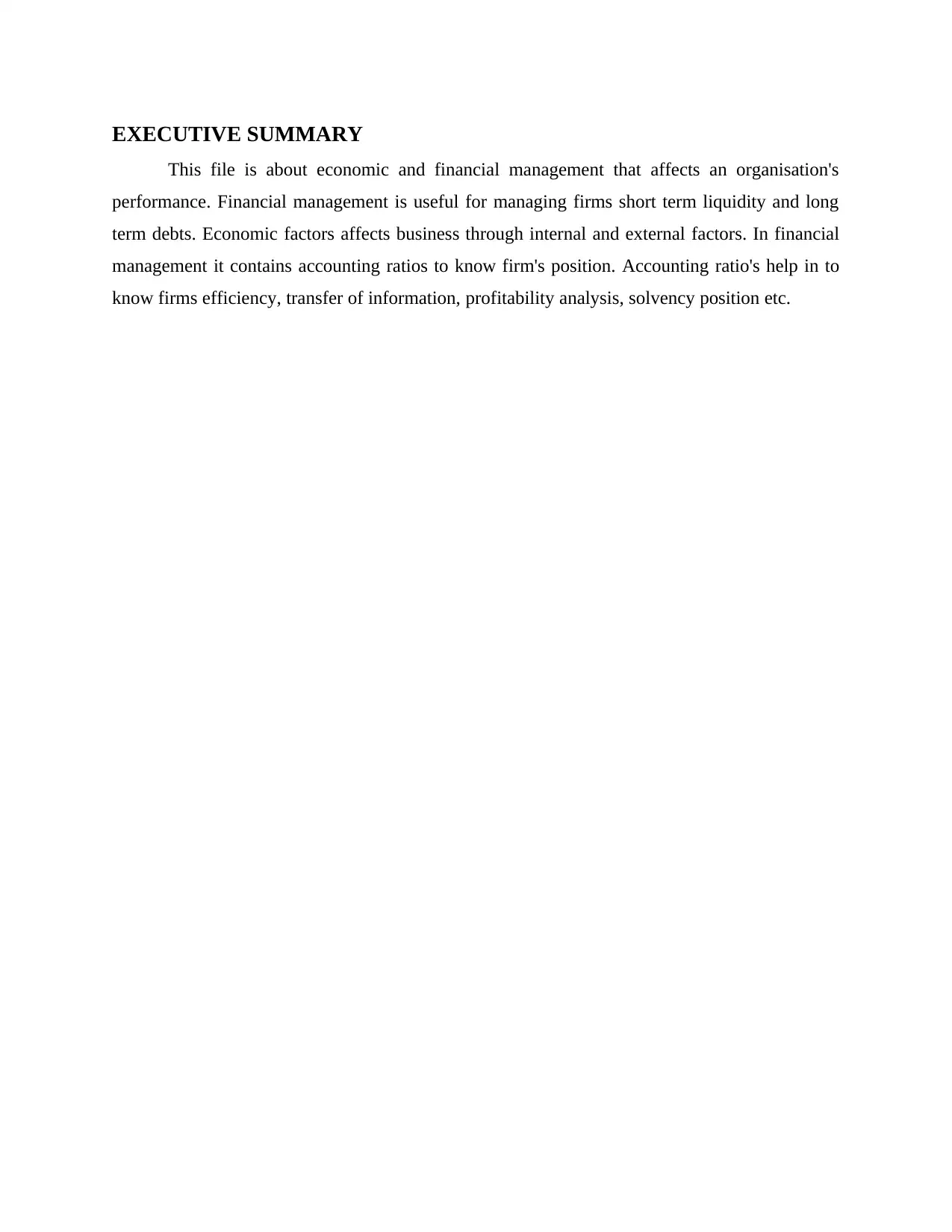
EXECUTIVE SUMMARY
This file is about economic and financial management that affects an organisation's
performance. Financial management is useful for managing firms short term liquidity and long
term debts. Economic factors affects business through internal and external factors. In financial
management it contains accounting ratios to know firm's position. Accounting ratio's help in to
know firms efficiency, transfer of information, profitability analysis, solvency position etc.
This file is about economic and financial management that affects an organisation's
performance. Financial management is useful for managing firms short term liquidity and long
term debts. Economic factors affects business through internal and external factors. In financial
management it contains accounting ratios to know firm's position. Accounting ratio's help in to
know firms efficiency, transfer of information, profitability analysis, solvency position etc.

Table of Contents
EXECUTIVE SUMMARY.............................................................................................................2
INTRODUCTION...........................................................................................................................1
MAIN BODY...................................................................................................................................1
Analysis the economic factors and their impacts on the business:..............................................1
Calculation of ratios of the British red cross for the past three years:.........................................3
Accounting ratios and their importance in business:...................................................................3
RECOMMENDETION....................................................................................................................8
CONCLUSION................................................................................................................................9
REFERENCES..............................................................................................................................10
EXECUTIVE SUMMARY.............................................................................................................2
INTRODUCTION...........................................................................................................................1
MAIN BODY...................................................................................................................................1
Analysis the economic factors and their impacts on the business:..............................................1
Calculation of ratios of the British red cross for the past three years:.........................................3
Accounting ratios and their importance in business:...................................................................3
RECOMMENDETION....................................................................................................................8
CONCLUSION................................................................................................................................9
REFERENCES..............................................................................................................................10
⊘ This is a preview!⊘
Do you want full access?
Subscribe today to unlock all pages.

Trusted by 1+ million students worldwide

Paraphrase This Document
Need a fresh take? Get an instant paraphrase of this document with our AI Paraphraser
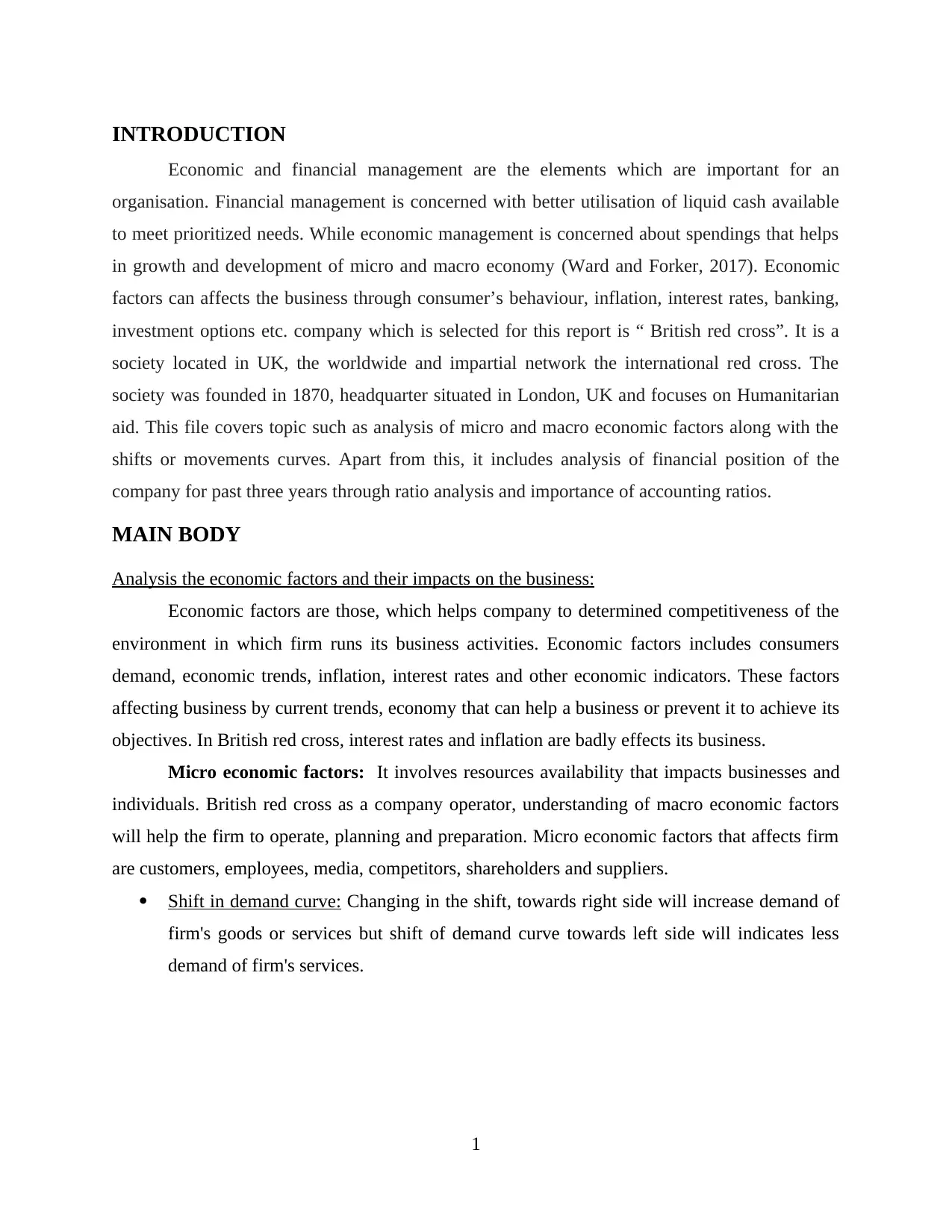
INTRODUCTION
Economic and financial management are the elements which are important for an
organisation. Financial management is concerned with better utilisation of liquid cash available
to meet prioritized needs. While economic management is concerned about spendings that helps
in growth and development of micro and macro economy (Ward and Forker, 2017). Economic
factors can affects the business through consumer’s behaviour, inflation, interest rates, banking,
investment options etc. company which is selected for this report is “ British red cross”. It is a
society located in UK, the worldwide and impartial network the international red cross. The
society was founded in 1870, headquarter situated in London, UK and focuses on Humanitarian
aid. This file covers topic such as analysis of micro and macro economic factors along with the
shifts or movements curves. Apart from this, it includes analysis of financial position of the
company for past three years through ratio analysis and importance of accounting ratios.
MAIN BODY
Analysis the economic factors and their impacts on the business:
Economic factors are those, which helps company to determined competitiveness of the
environment in which firm runs its business activities. Economic factors includes consumers
demand, economic trends, inflation, interest rates and other economic indicators. These factors
affecting business by current trends, economy that can help a business or prevent it to achieve its
objectives. In British red cross, interest rates and inflation are badly effects its business.
Micro economic factors: It involves resources availability that impacts businesses and
individuals. British red cross as a company operator, understanding of macro economic factors
will help the firm to operate, planning and preparation. Micro economic factors that affects firm
are customers, employees, media, competitors, shareholders and suppliers.
Shift in demand curve: Changing in the shift, towards right side will increase demand of
firm's goods or services but shift of demand curve towards left side will indicates less
demand of firm's services.
1
Economic and financial management are the elements which are important for an
organisation. Financial management is concerned with better utilisation of liquid cash available
to meet prioritized needs. While economic management is concerned about spendings that helps
in growth and development of micro and macro economy (Ward and Forker, 2017). Economic
factors can affects the business through consumer’s behaviour, inflation, interest rates, banking,
investment options etc. company which is selected for this report is “ British red cross”. It is a
society located in UK, the worldwide and impartial network the international red cross. The
society was founded in 1870, headquarter situated in London, UK and focuses on Humanitarian
aid. This file covers topic such as analysis of micro and macro economic factors along with the
shifts or movements curves. Apart from this, it includes analysis of financial position of the
company for past three years through ratio analysis and importance of accounting ratios.
MAIN BODY
Analysis the economic factors and their impacts on the business:
Economic factors are those, which helps company to determined competitiveness of the
environment in which firm runs its business activities. Economic factors includes consumers
demand, economic trends, inflation, interest rates and other economic indicators. These factors
affecting business by current trends, economy that can help a business or prevent it to achieve its
objectives. In British red cross, interest rates and inflation are badly effects its business.
Micro economic factors: It involves resources availability that impacts businesses and
individuals. British red cross as a company operator, understanding of macro economic factors
will help the firm to operate, planning and preparation. Micro economic factors that affects firm
are customers, employees, media, competitors, shareholders and suppliers.
Shift in demand curve: Changing in the shift, towards right side will increase demand of
firm's goods or services but shift of demand curve towards left side will indicates less
demand of firm's services.
1
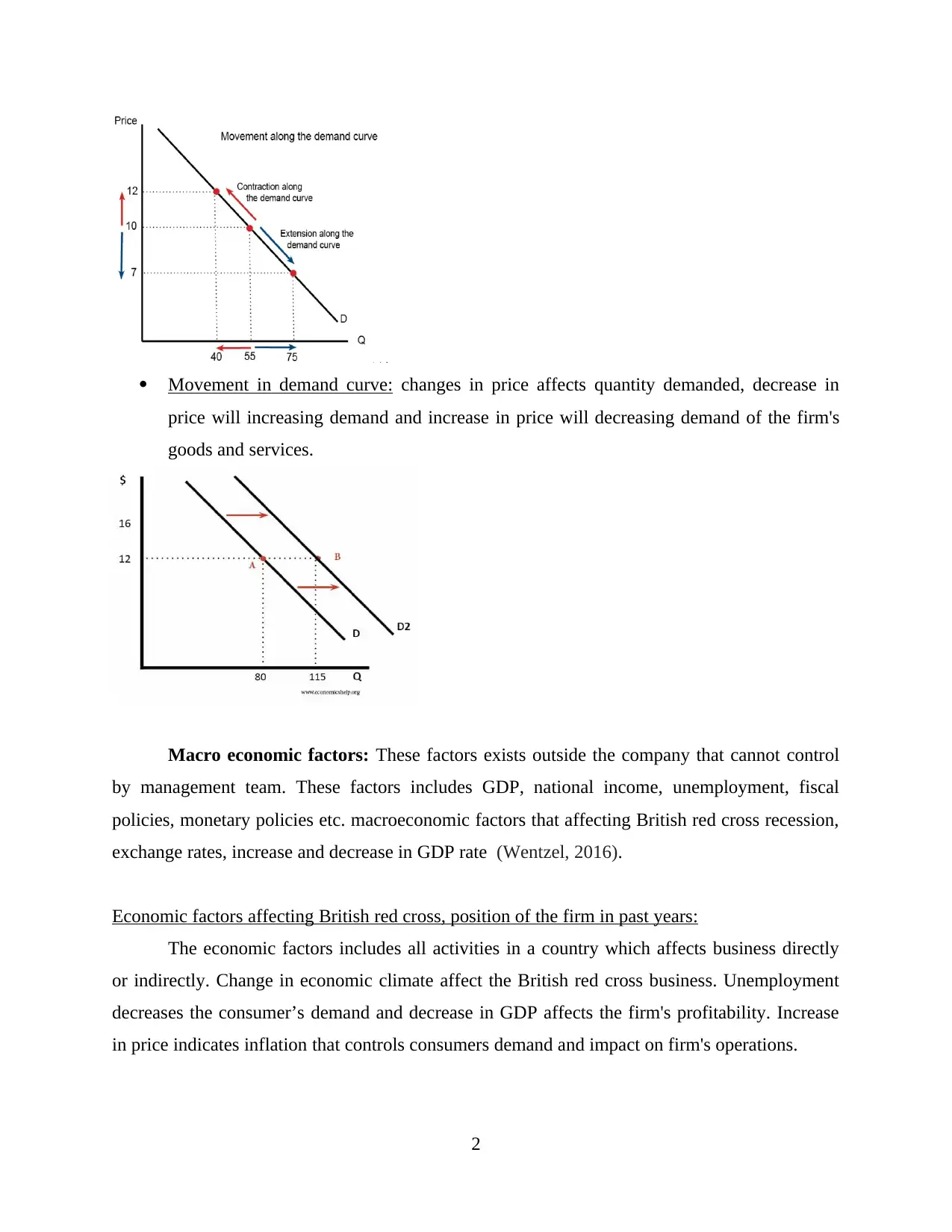
Movement in demand curve: changes in price affects quantity demanded, decrease in
price will increasing demand and increase in price will decreasing demand of the firm's
goods and services.
Macro economic factors: These factors exists outside the company that cannot control
by management team. These factors includes GDP, national income, unemployment, fiscal
policies, monetary policies etc. macroeconomic factors that affecting British red cross recession,
exchange rates, increase and decrease in GDP rate (Wentzel, 2016).
Economic factors affecting British red cross, position of the firm in past years:
The economic factors includes all activities in a country which affects business directly
or indirectly. Change in economic climate affect the British red cross business. Unemployment
decreases the consumer’s demand and decrease in GDP affects the firm's profitability. Increase
in price indicates inflation that controls consumers demand and impact on firm's operations.
2
price will increasing demand and increase in price will decreasing demand of the firm's
goods and services.
Macro economic factors: These factors exists outside the company that cannot control
by management team. These factors includes GDP, national income, unemployment, fiscal
policies, monetary policies etc. macroeconomic factors that affecting British red cross recession,
exchange rates, increase and decrease in GDP rate (Wentzel, 2016).
Economic factors affecting British red cross, position of the firm in past years:
The economic factors includes all activities in a country which affects business directly
or indirectly. Change in economic climate affect the British red cross business. Unemployment
decreases the consumer’s demand and decrease in GDP affects the firm's profitability. Increase
in price indicates inflation that controls consumers demand and impact on firm's operations.
2
⊘ This is a preview!⊘
Do you want full access?
Subscribe today to unlock all pages.

Trusted by 1+ million students worldwide
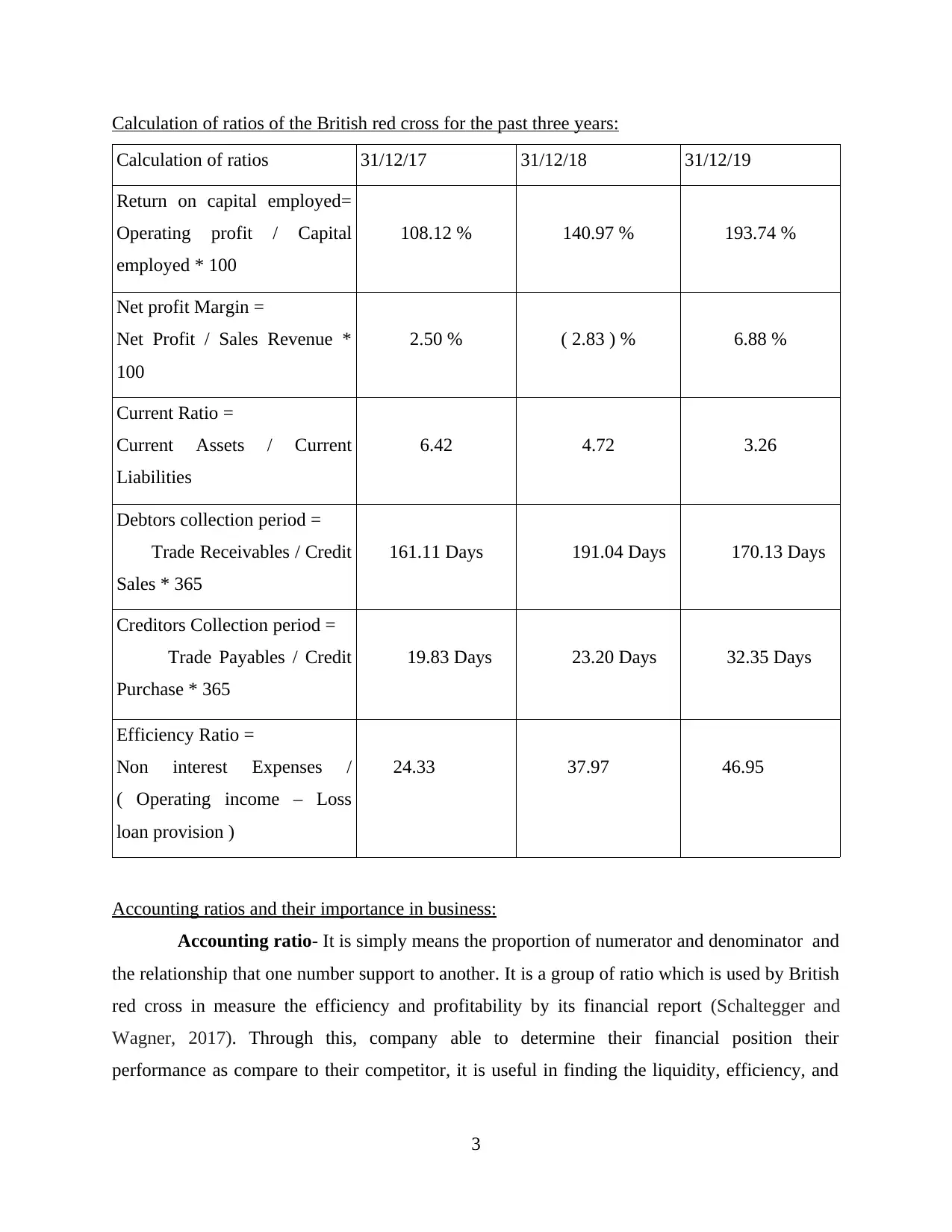
Calculation of ratios of the British red cross for the past three years:
Calculation of ratios 31/12/17 31/12/18 31/12/19
Return on capital employed=
Operating profit / Capital
employed * 100
108.12 % 140.97 % 193.74 %
Net profit Margin =
Net Profit / Sales Revenue *
100
2.50 % ( 2.83 ) % 6.88 %
Current Ratio =
Current Assets / Current
Liabilities
6.42 4.72 3.26
Debtors collection period =
Trade Receivables / Credit
Sales * 365
161.11 Days 191.04 Days 170.13 Days
Creditors Collection period =
Trade Payables / Credit
Purchase * 365
19.83 Days 23.20 Days 32.35 Days
Efficiency Ratio =
Non interest Expenses /
( Operating income – Loss
loan provision )
24.33 37.97 46.95
Accounting ratios and their importance in business:
Accounting ratio- It is simply means the proportion of numerator and denominator and
the relationship that one number support to another. It is a group of ratio which is used by British
red cross in measure the efficiency and profitability by its financial report (Schaltegger and
Wagner, 2017). Through this, company able to determine their financial position their
performance as compare to their competitor, it is useful in finding the liquidity, efficiency, and
3
Calculation of ratios 31/12/17 31/12/18 31/12/19
Return on capital employed=
Operating profit / Capital
employed * 100
108.12 % 140.97 % 193.74 %
Net profit Margin =
Net Profit / Sales Revenue *
100
2.50 % ( 2.83 ) % 6.88 %
Current Ratio =
Current Assets / Current
Liabilities
6.42 4.72 3.26
Debtors collection period =
Trade Receivables / Credit
Sales * 365
161.11 Days 191.04 Days 170.13 Days
Creditors Collection period =
Trade Payables / Credit
Purchase * 365
19.83 Days 23.20 Days 32.35 Days
Efficiency Ratio =
Non interest Expenses /
( Operating income – Loss
loan provision )
24.33 37.97 46.95
Accounting ratios and their importance in business:
Accounting ratio- It is simply means the proportion of numerator and denominator and
the relationship that one number support to another. It is a group of ratio which is used by British
red cross in measure the efficiency and profitability by its financial report (Schaltegger and
Wagner, 2017). Through this, company able to determine their financial position their
performance as compare to their competitor, it is useful in finding the liquidity, efficiency, and
3
Paraphrase This Document
Need a fresh take? Get an instant paraphrase of this document with our AI Paraphraser
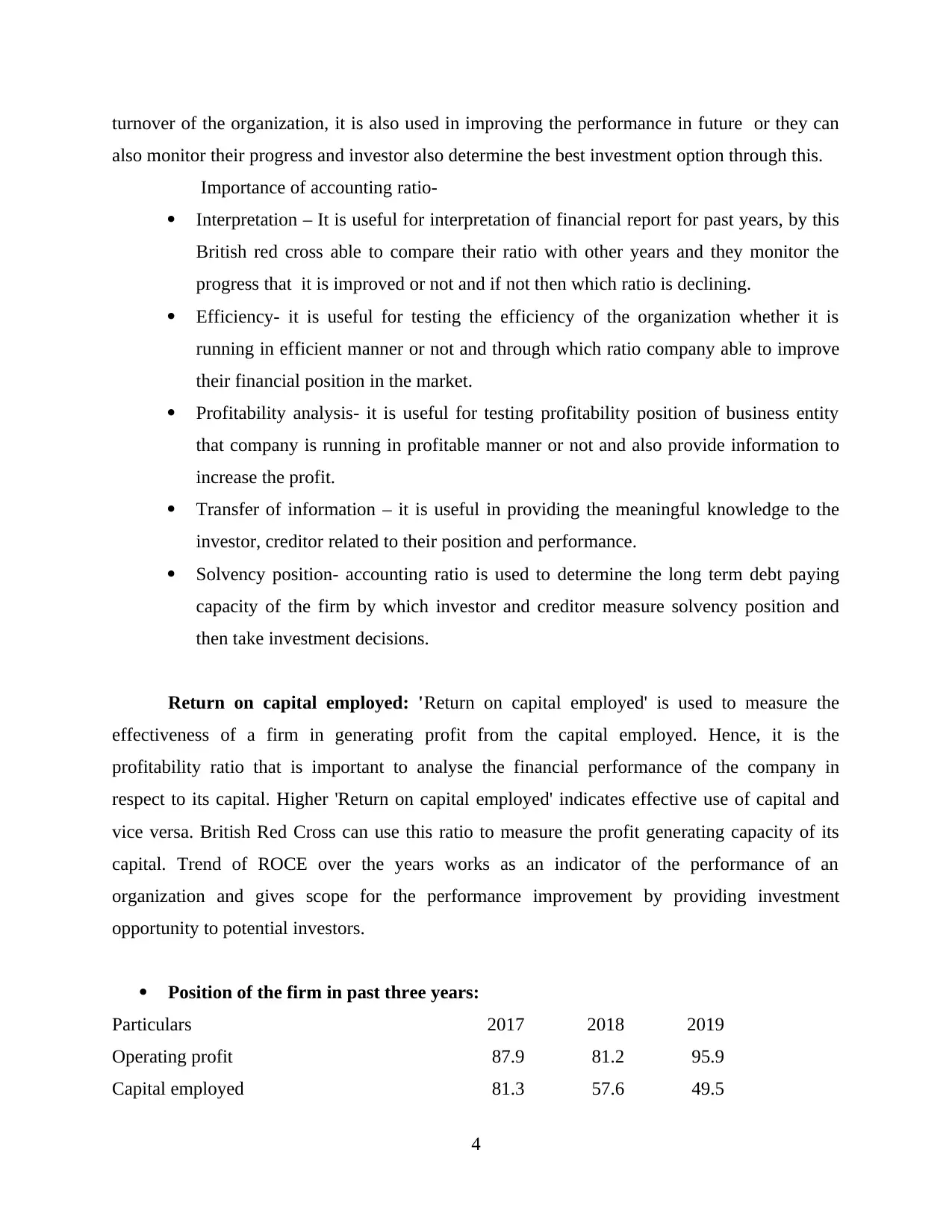
turnover of the organization, it is also used in improving the performance in future or they can
also monitor their progress and investor also determine the best investment option through this.
Importance of accounting ratio-
Interpretation – It is useful for interpretation of financial report for past years, by this
British red cross able to compare their ratio with other years and they monitor the
progress that it is improved or not and if not then which ratio is declining.
Efficiency- it is useful for testing the efficiency of the organization whether it is
running in efficient manner or not and through which ratio company able to improve
their financial position in the market.
Profitability analysis- it is useful for testing profitability position of business entity
that company is running in profitable manner or not and also provide information to
increase the profit.
Transfer of information – it is useful in providing the meaningful knowledge to the
investor, creditor related to their position and performance.
Solvency position- accounting ratio is used to determine the long term debt paying
capacity of the firm by which investor and creditor measure solvency position and
then take investment decisions.
Return on capital employed: 'Return on capital employed' is used to measure the
effectiveness of a firm in generating profit from the capital employed. Hence, it is the
profitability ratio that is important to analyse the financial performance of the company in
respect to its capital. Higher 'Return on capital employed' indicates effective use of capital and
vice versa. British Red Cross can use this ratio to measure the profit generating capacity of its
capital. Trend of ROCE over the years works as an indicator of the performance of an
organization and gives scope for the performance improvement by providing investment
opportunity to potential investors.
Position of the firm in past three years:
Particulars 2017 2018 2019
Operating profit 87.9 81.2 95.9
Capital employed 81.3 57.6 49.5
4
also monitor their progress and investor also determine the best investment option through this.
Importance of accounting ratio-
Interpretation – It is useful for interpretation of financial report for past years, by this
British red cross able to compare their ratio with other years and they monitor the
progress that it is improved or not and if not then which ratio is declining.
Efficiency- it is useful for testing the efficiency of the organization whether it is
running in efficient manner or not and through which ratio company able to improve
their financial position in the market.
Profitability analysis- it is useful for testing profitability position of business entity
that company is running in profitable manner or not and also provide information to
increase the profit.
Transfer of information – it is useful in providing the meaningful knowledge to the
investor, creditor related to their position and performance.
Solvency position- accounting ratio is used to determine the long term debt paying
capacity of the firm by which investor and creditor measure solvency position and
then take investment decisions.
Return on capital employed: 'Return on capital employed' is used to measure the
effectiveness of a firm in generating profit from the capital employed. Hence, it is the
profitability ratio that is important to analyse the financial performance of the company in
respect to its capital. Higher 'Return on capital employed' indicates effective use of capital and
vice versa. British Red Cross can use this ratio to measure the profit generating capacity of its
capital. Trend of ROCE over the years works as an indicator of the performance of an
organization and gives scope for the performance improvement by providing investment
opportunity to potential investors.
Position of the firm in past three years:
Particulars 2017 2018 2019
Operating profit 87.9 81.2 95.9
Capital employed 81.3 57.6 49.5
4

results 108.12 140.97 193.74
Return on capital employed is useful to find firm's profitability. It shows how much profit
firm generates on each dollar. Higher the ratio will be most favourable that means profit
generates on each dollar by firm is higher (Popkova and Parakhina, 2018). In British red cross
investors are seeks to see how firm efficiently uses its capital employed for long term financing
strategies. In 2017, the firm generates 108.12% return on capital employed and In 2018, firms
return increased by 140.97%. it shows firm's asset less liabilities. In one year it shows how firm's
asset are using in context to long term financing. Apart from this in year 2019 organisation's
return on capital increased by 193.74% that shows in three years firm's ratio is higher than last
year and it would be profitable for company. The reason behind it, is firm reduces its cost and
increased its customers or sales. And the another reason for it, selling of unproductive or
unnecessary asset.
Net profit margin: This ratio compares the net profit of the company with revenue
generated in a period of time. It is expressed in percentage. It evaluates the net profit obtained by
firm on per revenue gained. It is an important indicator for financial health of British Red Cross
to gain insight for profitability of a business as it shows actual gain of the company after
considering all expenses and taxes charged. Hence, final benefit of a business can be evaluated
through this ratio. Its works as a scorecard for operating efficiency of the company. Performance
benchmark can be set by business with the use of net profit margin.
Position of the firm in past three years:
Net profit margin 2017 2018 2019
Net profit 2.2 -2.3 6.6
sales revenue 87.9 81.2 95.9
results 2.50 -2.83 6.88
Net profit margin indicates generated net income of firm as a percentage of revenue. It
helps investors to assess firm's profit generated from its assets. In year 2017 British red cross
generates its profit margin at 2.50% and in 2018 it decreased by 2.83%. decreasing in net profit
5
Return on capital employed is useful to find firm's profitability. It shows how much profit
firm generates on each dollar. Higher the ratio will be most favourable that means profit
generates on each dollar by firm is higher (Popkova and Parakhina, 2018). In British red cross
investors are seeks to see how firm efficiently uses its capital employed for long term financing
strategies. In 2017, the firm generates 108.12% return on capital employed and In 2018, firms
return increased by 140.97%. it shows firm's asset less liabilities. In one year it shows how firm's
asset are using in context to long term financing. Apart from this in year 2019 organisation's
return on capital increased by 193.74% that shows in three years firm's ratio is higher than last
year and it would be profitable for company. The reason behind it, is firm reduces its cost and
increased its customers or sales. And the another reason for it, selling of unproductive or
unnecessary asset.
Net profit margin: This ratio compares the net profit of the company with revenue
generated in a period of time. It is expressed in percentage. It evaluates the net profit obtained by
firm on per revenue gained. It is an important indicator for financial health of British Red Cross
to gain insight for profitability of a business as it shows actual gain of the company after
considering all expenses and taxes charged. Hence, final benefit of a business can be evaluated
through this ratio. Its works as a scorecard for operating efficiency of the company. Performance
benchmark can be set by business with the use of net profit margin.
Position of the firm in past three years:
Net profit margin 2017 2018 2019
Net profit 2.2 -2.3 6.6
sales revenue 87.9 81.2 95.9
results 2.50 -2.83 6.88
Net profit margin indicates generated net income of firm as a percentage of revenue. It
helps investors to assess firm's profit generated from its assets. In year 2017 British red cross
generates its profit margin at 2.50% and in 2018 it decreased by 2.83%. decreasing in net profit
5
⊘ This is a preview!⊘
Do you want full access?
Subscribe today to unlock all pages.

Trusted by 1+ million students worldwide
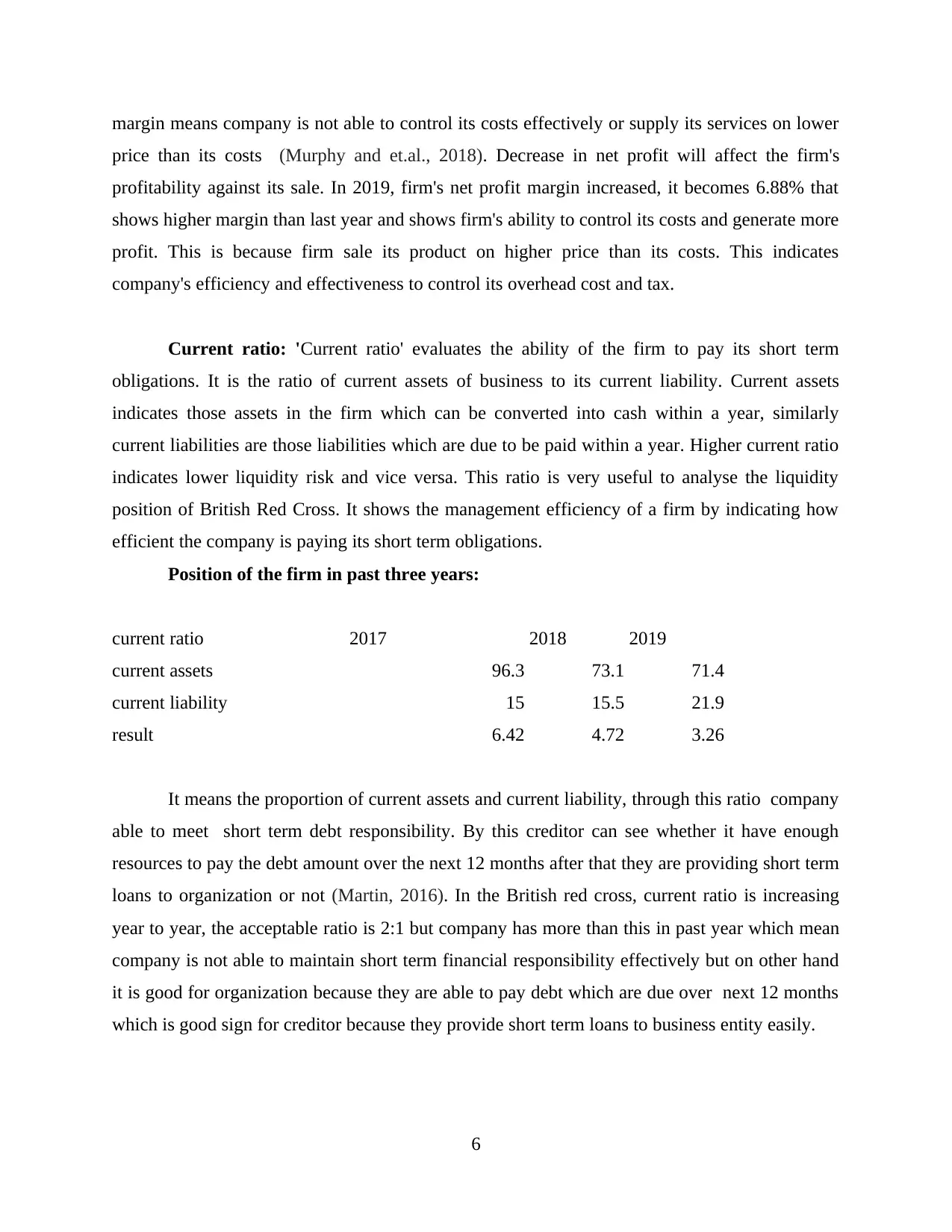
margin means company is not able to control its costs effectively or supply its services on lower
price than its costs (Murphy and et.al., 2018). Decrease in net profit will affect the firm's
profitability against its sale. In 2019, firm's net profit margin increased, it becomes 6.88% that
shows higher margin than last year and shows firm's ability to control its costs and generate more
profit. This is because firm sale its product on higher price than its costs. This indicates
company's efficiency and effectiveness to control its overhead cost and tax.
Current ratio: 'Current ratio' evaluates the ability of the firm to pay its short term
obligations. It is the ratio of current assets of business to its current liability. Current assets
indicates those assets in the firm which can be converted into cash within a year, similarly
current liabilities are those liabilities which are due to be paid within a year. Higher current ratio
indicates lower liquidity risk and vice versa. This ratio is very useful to analyse the liquidity
position of British Red Cross. It shows the management efficiency of a firm by indicating how
efficient the company is paying its short term obligations.
Position of the firm in past three years:
current ratio 2017 2018 2019
current assets 96.3 73.1 71.4
current liability 15 15.5 21.9
result 6.42 4.72 3.26
It means the proportion of current assets and current liability, through this ratio company
able to meet short term debt responsibility. By this creditor can see whether it have enough
resources to pay the debt amount over the next 12 months after that they are providing short term
loans to organization or not (Martin, 2016). In the British red cross, current ratio is increasing
year to year, the acceptable ratio is 2:1 but company has more than this in past year which mean
company is not able to maintain short term financial responsibility effectively but on other hand
it is good for organization because they are able to pay debt which are due over next 12 months
which is good sign for creditor because they provide short term loans to business entity easily.
6
price than its costs (Murphy and et.al., 2018). Decrease in net profit will affect the firm's
profitability against its sale. In 2019, firm's net profit margin increased, it becomes 6.88% that
shows higher margin than last year and shows firm's ability to control its costs and generate more
profit. This is because firm sale its product on higher price than its costs. This indicates
company's efficiency and effectiveness to control its overhead cost and tax.
Current ratio: 'Current ratio' evaluates the ability of the firm to pay its short term
obligations. It is the ratio of current assets of business to its current liability. Current assets
indicates those assets in the firm which can be converted into cash within a year, similarly
current liabilities are those liabilities which are due to be paid within a year. Higher current ratio
indicates lower liquidity risk and vice versa. This ratio is very useful to analyse the liquidity
position of British Red Cross. It shows the management efficiency of a firm by indicating how
efficient the company is paying its short term obligations.
Position of the firm in past three years:
current ratio 2017 2018 2019
current assets 96.3 73.1 71.4
current liability 15 15.5 21.9
result 6.42 4.72 3.26
It means the proportion of current assets and current liability, through this ratio company
able to meet short term debt responsibility. By this creditor can see whether it have enough
resources to pay the debt amount over the next 12 months after that they are providing short term
loans to organization or not (Martin, 2016). In the British red cross, current ratio is increasing
year to year, the acceptable ratio is 2:1 but company has more than this in past year which mean
company is not able to maintain short term financial responsibility effectively but on other hand
it is good for organization because they are able to pay debt which are due over next 12 months
which is good sign for creditor because they provide short term loans to business entity easily.
6
Paraphrase This Document
Need a fresh take? Get an instant paraphrase of this document with our AI Paraphraser

Average Receivable days/ Debtors collection period: Debtors collection period
indicates the amount of time required to collect receivables from debtors of a firm. Long debtors
collection periods represents late or delayed payment by debtors (Kuzminov and et.al., 2018).
Short debtors collection period is an indicator of efficiency of the company. It is essential to
calculate as it allows British Red Cross to compare its actual collection period with granted
period. Also, regular evaluation of average receivable days reduces the risk of bad debts in
business. It is the tool for receiving quick payments which gives an organization strategic
advantage against competitors. It helps in maintaining cash flow in a firm.
Position of the firm in past three years:
debtor turnover ratio 2017 2018 2019
trade receivable 38.8 42.5 44.7
credit sales 87.9 81.2 95.9
results 161.11 191.04 170.13
It means the days of the collection or the amount of time take to collect all debt of the
company. The acceptable period follow by all is 90 days (nekwe, Jin and Valenzuela, 2019). In
British red cross, the collection period is increasing year by year which is bad for the company
because firm is not able to collect debt in small period their collection period is increasing year
by year, they have to maintain their collection period for effective running or for better
performance,if it is increasing year by year it is harmful for company and investor is not able to
invest in that organisation because they have no collected debt on time which mean they have no
excess resources to utilise, the less collection period is there it is beneficial for the organization
because it is able to collect debt at faster rate .
Average Payable days/ Creditors collection period: It gives insight about average time
taken by an organization to settle debts with its creditors. It is calculated by dividing number of
working days with payables turnover ratio. High creditors collection period is a positive indicator
for company as it shows that longer credit period is allowed by suppliers and opposite is the case
with low credit collection period (Hu, Zhang and Chao, 2019). British Red Cross can use it to
predict upcoming cash flow problems and to ensure timely payment to creditors which is very
7
indicates the amount of time required to collect receivables from debtors of a firm. Long debtors
collection periods represents late or delayed payment by debtors (Kuzminov and et.al., 2018).
Short debtors collection period is an indicator of efficiency of the company. It is essential to
calculate as it allows British Red Cross to compare its actual collection period with granted
period. Also, regular evaluation of average receivable days reduces the risk of bad debts in
business. It is the tool for receiving quick payments which gives an organization strategic
advantage against competitors. It helps in maintaining cash flow in a firm.
Position of the firm in past three years:
debtor turnover ratio 2017 2018 2019
trade receivable 38.8 42.5 44.7
credit sales 87.9 81.2 95.9
results 161.11 191.04 170.13
It means the days of the collection or the amount of time take to collect all debt of the
company. The acceptable period follow by all is 90 days (nekwe, Jin and Valenzuela, 2019). In
British red cross, the collection period is increasing year by year which is bad for the company
because firm is not able to collect debt in small period their collection period is increasing year
by year, they have to maintain their collection period for effective running or for better
performance,if it is increasing year by year it is harmful for company and investor is not able to
invest in that organisation because they have no collected debt on time which mean they have no
excess resources to utilise, the less collection period is there it is beneficial for the organization
because it is able to collect debt at faster rate .
Average Payable days/ Creditors collection period: It gives insight about average time
taken by an organization to settle debts with its creditors. It is calculated by dividing number of
working days with payables turnover ratio. High creditors collection period is a positive indicator
for company as it shows that longer credit period is allowed by suppliers and opposite is the case
with low credit collection period (Hu, Zhang and Chao, 2019). British Red Cross can use it to
predict upcoming cash flow problems and to ensure timely payment to creditors which is very
7
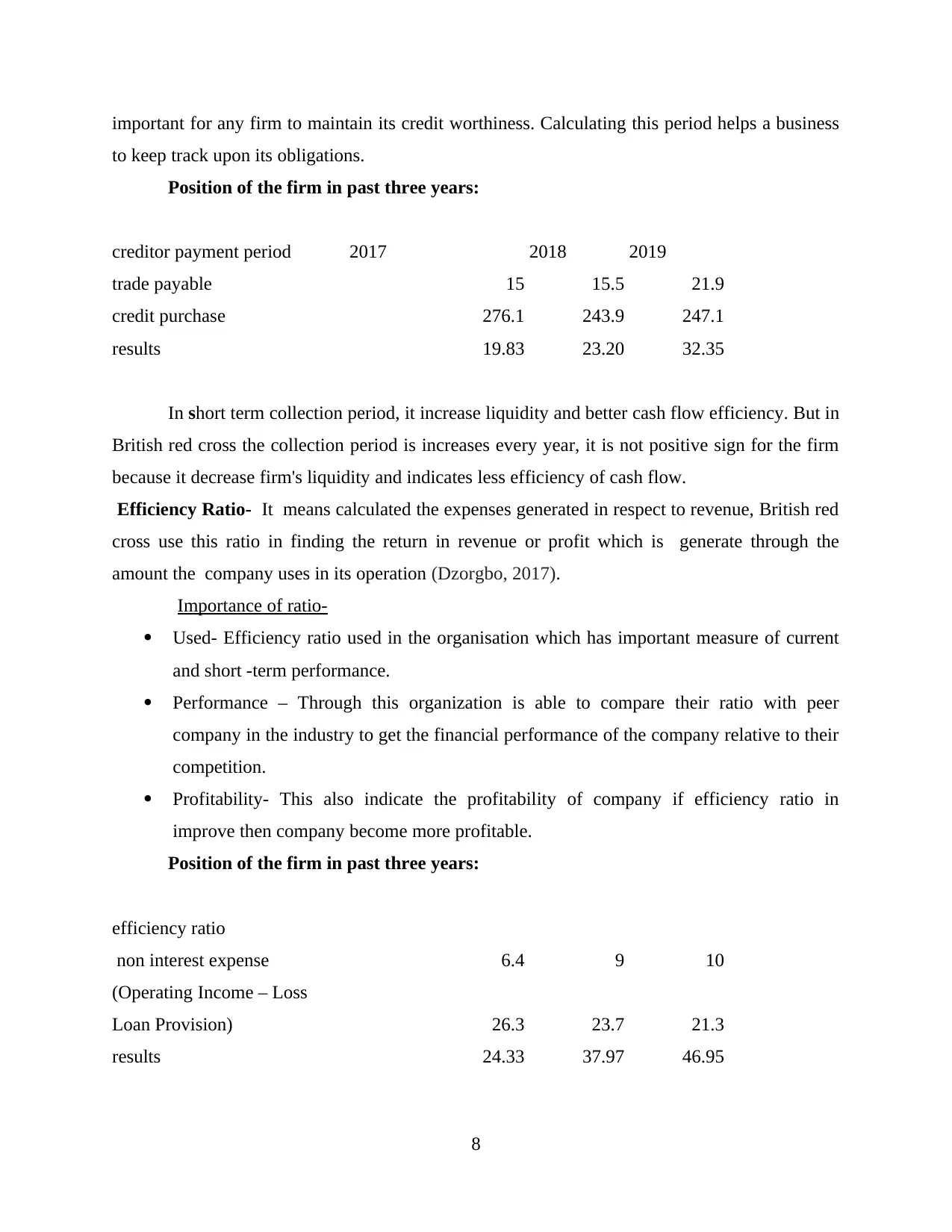
important for any firm to maintain its credit worthiness. Calculating this period helps a business
to keep track upon its obligations.
Position of the firm in past three years:
creditor payment period 2017 2018 2019
trade payable 15 15.5 21.9
credit purchase 276.1 243.9 247.1
results 19.83 23.20 32.35
In short term collection period, it increase liquidity and better cash flow efficiency. But in
British red cross the collection period is increases every year, it is not positive sign for the firm
because it decrease firm's liquidity and indicates less efficiency of cash flow.
Efficiency Ratio- It means calculated the expenses generated in respect to revenue, British red
cross use this ratio in finding the return in revenue or profit which is generate through the
amount the company uses in its operation (Dzorgbo, 2017).
Importance of ratio-
Used- Efficiency ratio used in the organisation which has important measure of current
and short -term performance.
Performance – Through this organization is able to compare their ratio with peer
company in the industry to get the financial performance of the company relative to their
competition.
Profitability- This also indicate the profitability of company if efficiency ratio in
improve then company become more profitable.
Position of the firm in past three years:
efficiency ratio
non interest expense 6.4 9 10
(Operating Income – Loss
Loan Provision) 26.3 23.7 21.3
results 24.33 37.97 46.95
8
to keep track upon its obligations.
Position of the firm in past three years:
creditor payment period 2017 2018 2019
trade payable 15 15.5 21.9
credit purchase 276.1 243.9 247.1
results 19.83 23.20 32.35
In short term collection period, it increase liquidity and better cash flow efficiency. But in
British red cross the collection period is increases every year, it is not positive sign for the firm
because it decrease firm's liquidity and indicates less efficiency of cash flow.
Efficiency Ratio- It means calculated the expenses generated in respect to revenue, British red
cross use this ratio in finding the return in revenue or profit which is generate through the
amount the company uses in its operation (Dzorgbo, 2017).
Importance of ratio-
Used- Efficiency ratio used in the organisation which has important measure of current
and short -term performance.
Performance – Through this organization is able to compare their ratio with peer
company in the industry to get the financial performance of the company relative to their
competition.
Profitability- This also indicate the profitability of company if efficiency ratio in
improve then company become more profitable.
Position of the firm in past three years:
efficiency ratio
non interest expense 6.4 9 10
(Operating Income – Loss
Loan Provision) 26.3 23.7 21.3
results 24.33 37.97 46.95
8
⊘ This is a preview!⊘
Do you want full access?
Subscribe today to unlock all pages.

Trusted by 1+ million students worldwide
1 out of 14
Related Documents
Your All-in-One AI-Powered Toolkit for Academic Success.
+13062052269
info@desklib.com
Available 24*7 on WhatsApp / Email
![[object Object]](/_next/static/media/star-bottom.7253800d.svg)
Unlock your academic potential
Copyright © 2020–2025 A2Z Services. All Rights Reserved. Developed and managed by ZUCOL.





